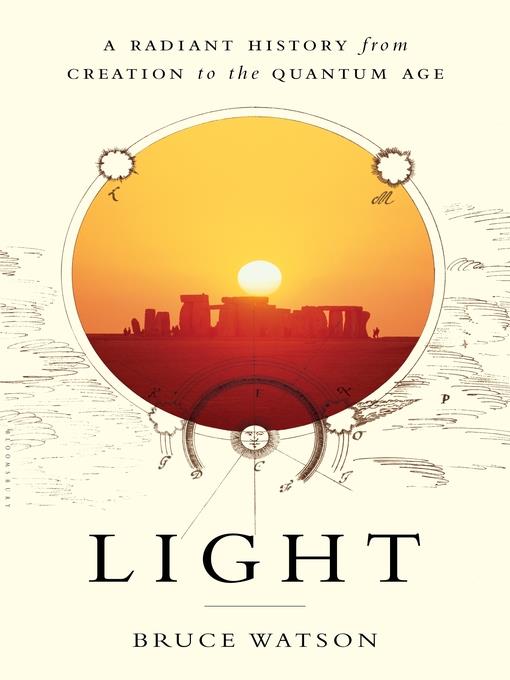
Light
A Radiant History from Creation to the Quantum Age
کتاب های مرتبط
- اطلاعات
- نقد و بررسی
- دیدگاه کاربران
نقد و بررسی

November 30, 2015
Watson (Freedom Summer), a frequent contributor to Smithsonian, leads an engrossing tour of humans’ longtime fascination with and study of light. He bookends his narrative with accounts of his visits to Stonehenge, for the summer solstice, and Ireland’s Newgrange, for the winter solstice. Between these brilliantly described personal experiences, Watson traces scientific inquiry into the nature of light from the ancient Greeks, including Empedocles and Euclid, through scholars of the golden age of Islam such as Ibn al-Haytham (aka Alhazen), to the more modern figures of Galileo Galilei, Isaac Newton, Albert Einstein, and Richard Feynman. This isn’t just a book of science history; inventors such as photography pioneer Louis Daguerre and light bulb originator Thomas Edison take their places amongst the academics of light, and Watson includes artists as well. Abbot Suger, designer of the church at Saint-Denis, France, receives his due along with the polymath Leonardo da Vinci, painters Rembrandt van Rijn and J.M.W. Turner, composer Joseph Haydn, poet and artist William Blake, and many others. Watson even includes an appendix on the light that some people see during near-death experiences. Weaving his own journeys and experiments throughout the work, Watson provides a panoramic view of human engagement with this most curiosity-inducing phenomenon.

Starred review from November 15, 2015
The usual popular-science history of light begins with the ancient Greeks and peters out soon after Einstein, but this fine account by Smithsonian contributing writer Watson (Freedom Summer: The Savage Season of 1964 that Made Mississippi Burn and Made America a Democracy, 2010, etc.) paints with a broader brush. The author emphasizes that humans paid attention to light and darkness long before they tried to understand it. With increasing knowledge came conveniences and inventions along with new ways of observing the world--i.e., art. Throughout the book, Watson gives close attention to both science and art. All religions venerate light, which the author illustrates in his first 60 pages, including many quotes from sacred texts and holy men that show great passion without actually explaining anything. Ancient thinkers argued a problem that now seems odd. Do we see because light flows from our eyes toward the world or in the opposite direction? Aristotle got it wrong; only in the Middle Ages did Arab scientists deliver a convincing argument. Watson's artistic Renaissance begins with a new birth of vision. Perspective in painting appeared in the 15th century, as artists teased out the secrets of light, shading, and color. The scientific Renaissance arrives in the following chapter, and Isaac Newton receives his own (gravity gets the headlines, but his optical studies were equally revolutionary). The author proceeds with chapters devoted to physics, the humanities, or both (19th-century France invented both photography and impressionism). Watson's examination of technology monopolizes the book's final third, as the century and a half that began with Thomas Edison's incandescent bulb (already fading into obsolescence) has swamped the world in light pouring out of lasers, masers, LEDs, and optical scanners. An ingenious combination of science and art history.
COPYRIGHT(2015) Kirkus Reviews, ALL RIGHTS RESERVED.

Starred review from December 1, 2015
Watson is an excellent writer, and if this book doesn't become the popular primer on its subject for quite some time, we'll have to call out the conspiracy theorists to explain. Bookended by visits to those modern-day gawker-magnets, Stonehenge and Newgrange, the story he tells is a thread spun of the three strands of religion and philosophy, art, and science. Many early religions regarded light itself as God; Judaism significantly differed by conceiving light as being God-proclaimed. That got the scientific ball rolling as a rational attempt to answer the question of what light is. That answer still eludes us, for how can it be that, as quantum physics explains, the irreducible constituent of light, the photon, is without mass (hence, cannot decay and is immortal) and spins in a pair whose members change direction simultaneously, though they are at opposite ends of the universe? As religion, philosophy, and science pondered and predicated what light is, artists, including architects, painters, and photographers re-created light in terms of stone, pigment, and chemical reaction. This is a story and a book chock-full of great and fascinating figures, each of whose personality and doings Watson deftly presents without detracting from the impetus of his millennia-spanning narrative. A dazzling book, as seems completely appropriate.(Reprinted with permission of Booklist, copyright 2015, American Library Association.)

























دیدگاه کاربران